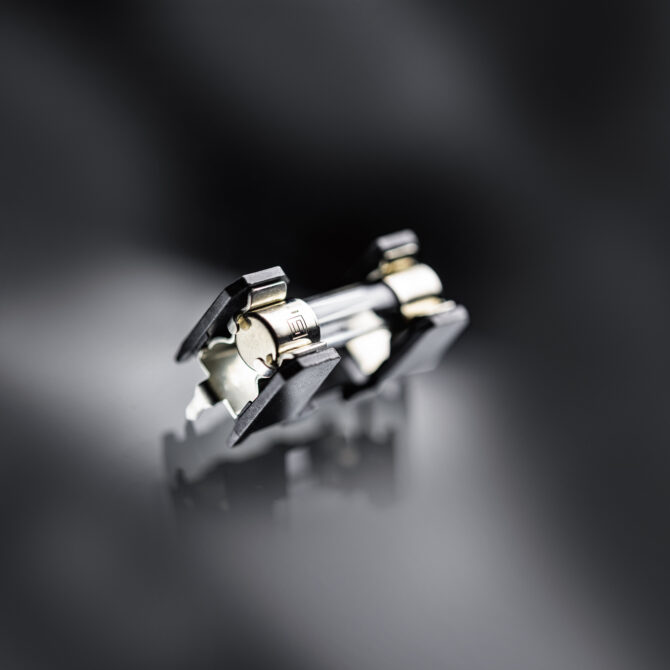
Through hole technology for the reflow oven
EP&T Magazine
Circuit Protection Production / Materials Supply Chain circuit protection pcb production Schurter surface mount through-holeThe use of two technologies has consequences in the soldering process
Electrical and electronic components come in a wide variety of sizes and mounting technologies. The classic is through hole technology (THT), while its modern counterpart is surface-mounting technology (SMT). Unfortunately, these two technologies, which are combined in almost every electronic device, require different soldering methods. A dilemma? Yes and no.
At the beginning of the 20th century, there were no printed circuit boards (pcb). All components available at that time were wired freely by hand. It was not until around 1920 that the first prototypes were created: stamped conductor tracks riveted to hard paper and held together with sheet metal springs. In 1943, the first patent was granted for a pcb.

Schurter OGN is an open fuse holder for 5×20 fuses that can be soldered in the reflow oven. Device can also be converted into a closed fuse holder by means of a cover. Source: Schurter
Through Hole
It was not until the early 1950s that pcbs slowly gained acceptance. Through hole technology first emerged in Germany, as the connecting wires of components were inserted through drilled holes in the pcb, which were provided with copper conductor tracks on their underside. This approach simplified production and at the same time reduced the error rate during wiring. Today, this is called THT: Through Hole Technology.
Surface-mount
Surface-mount technology (SMT) is not that much younger, even though it is used for almost all modern electronic products. Its beginnings can be found in the 1960s, developed by IBM for the computers of the Saturn and Apollo missions. The reasons given for this development at the time were the cramped space conditions in the spaceships and a reduction in circuit impedance to increase switching frequencies. Miniaturization SMT and THT both have a fixed place on the production floor of every contract electronics manufacturer (CEM) today. The increasing customer demand for mobile electronic devices is shifting the focus more and more to surface mount technology. Usually SMT components are much smaller and thus allow more compact end-devices. In contrast to through-hole mounting, SMT components are ‘glued’ directly onto the copper-clad surface of the board and then soldered in a reflow oven. Often, an SMT pcb permits assembly on both sides, which doubles the possible, fully automated assembly density.
Hybrid consequences
However, not every component can be reduced in size at will. Stationary electronic devices almost always have a built-in power supply. Traditionally, this consists of a transformer, capacitors, resistors and a rectifier. However, even the switching power supplies used very frequently today cannot be ‘shrunk’ to miniature dimensions, depending on the power required. Power needs space.
If, for example, the power supply also has to be placed on the SMT circuit board, then it quickly becomes a tight squeeze for a transformer. Or let’s consider the question of fuse protection: If a fuse blows in the event of an overcurrent, then it would be extremely useful if this fuse could be replaced without great effort. This need gave rise to hybrids: SMT circuit boards that contain additional drill holes for THT components.
The use of two technologies has consequences in the soldering process. For the CEM, this means that each board must undergo two soldering processes. One for the surface-mounted components (reflow method) and a second for the components in through-hole assembly (wave soldering). It goes without saying that two soldering processes are associated with significantly higher costs and a longer production time. In addition, two soldering systems must be available. But, there are other disadvantages as well.
Issue: Aging
If a hybrid pcb has to go through two soldering processes, many components are heated twice to temperatures well above 200°C. This is not beneficial to them. High temperatures will shorten the lifetime of any electronic component.
Issue: misplacement
The double soldering process poses an additional risk from its practical implementation: It is usually the case that the THT components are inserted after the reflow soldering process for SMT. In particular, manual placement of the components for the second soldering cycle in the wave bath involves a massively increased risk of incorrect placement.
Approach: no hybrids
To avoid these problems, there are several approaches. The simplest is to prevent them from occurring altogether. In other words, use only SMT or only THT components. Then a single soldering process is always sufficient. However, this is often not possible in practice due to the technical properties that the end product to be soldered should have.
Alternative: THR
‘Through hole reflow’ (THR) are equipped with through hole technology, and are specially designed for automated assembly and high thermal stress in the reflow oven. During the assembly process, a paste is first printed in the vias for the THT pins, and then the component is pushed through the solder paste. As the paste melts in the reflow oven, the liquid solder retracts into the vias due to wetting and capillary forces, forming a clean solder joint. The two technologies provide one highly efficient soldering process.
Fuse protection
With this in mind, we should once again take a look at the circuit protection of a fully automatically assembled pcb. It would be highly advantageous to install a fuse holder on the SMT board, which can also be soldered right away in the reflow process.
It’s nice to know that one soldering process is enough, isn’t it?
——————————
This article was written and submitted by Schurter Group, a Swiss-based technology company and specialized producer of electronic components.
